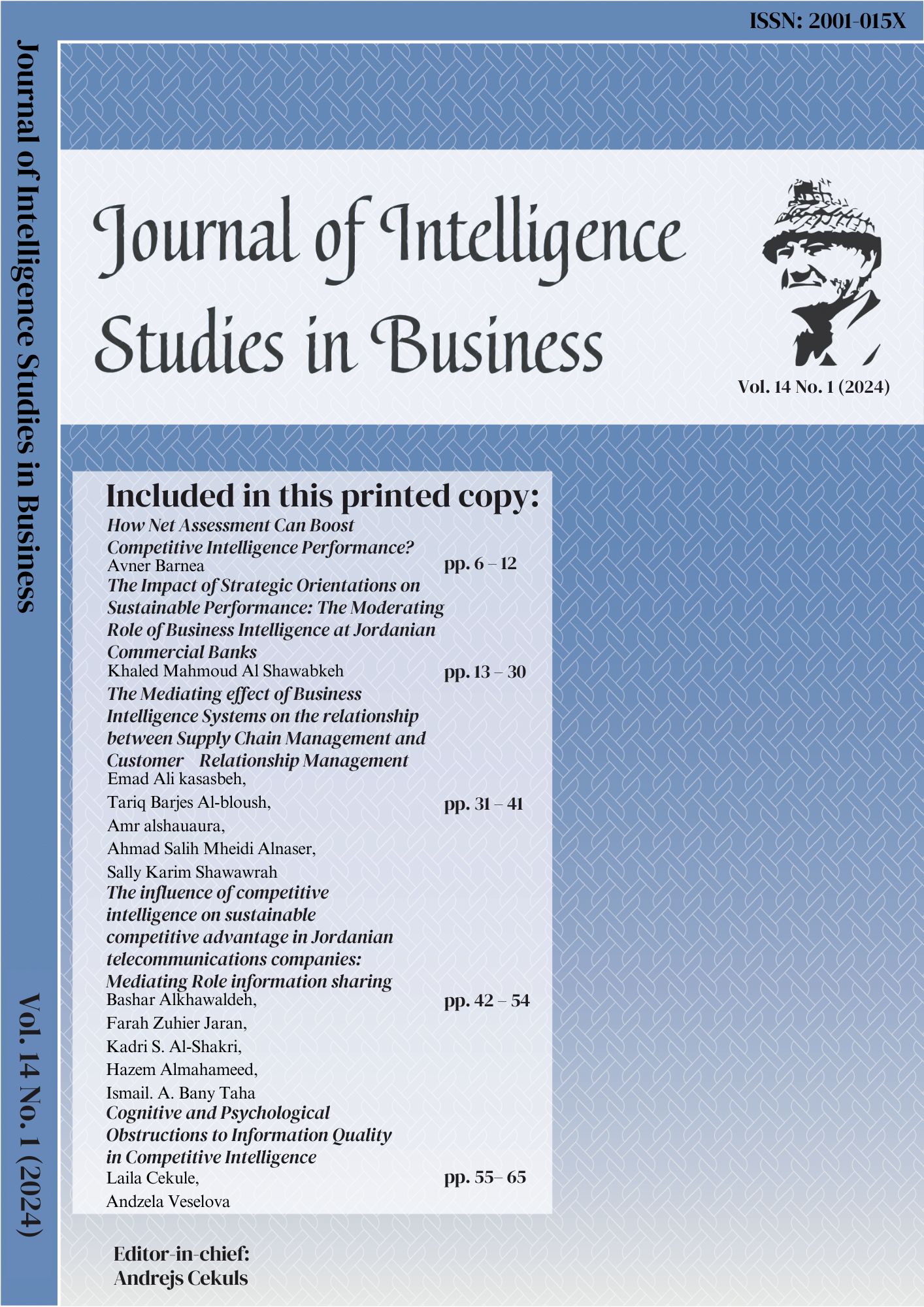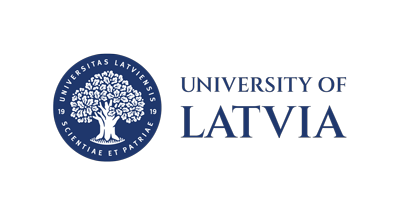The influence of competitive intelligence on sustainable competitive advantage in Jordanian telecommunications companies: Mediating Role information sharing
DOI:
https://doi.org/10.37380/jisib.v14.i1.2488Keywords:
Competitive Intelligence, Information Sharing, Jordanian Telecommunications Companies, PLS-SEM, Sustainable Competitive AdvantageAbstract
This study investigates the influence of competitive intelligence (CI) on sustainable competitive advantage (SCA) in Jordanian telecommunications companies, with a specific focus on the mediating role of information sharing (IS). A sample of approximately 200 participants, comprising individuals knowledgeable about or involved in CI practices within their organizations, is targeted for this research. Stratified random sampling, complemented by convenience sampling methods, ensures representative participation from various departments and hierarchical levels within telecommunications firms. Data is collected through structured questionnaires, employing validated scales to measure CI practices, IS behaviors, and SCA. The data analysis was carried out using Partial Least Squares Structural Equation Modelling (PLS-SEM), which can be used to investigate the direct and indirect effects. The results show a weak direct effect of CI on SCA and a strong and highly significant direct effect of CI on IS. In addition, IS has a significant positive effect on SCA. The mediation analysis indicates that IS fully mediates CI-SCA relationship, indicating how important information sharing is for the transformation of CI into sustainable competitive advantage in Jordanian telecommunication companies. These findings enhance our knowledge about the intricate relationships between CI, IS and SCA hence giving managers practical ideas on how to improve their competitiveness in the telecommunications industry.
References
Abbas, A. F., Jusoh, A., Mas’ od, A., Alsharif, A. H., & Ali, J. (2022). Bibliometrix analysis of information sharing in social media. Cogent Business & Management, 9(1), 2016556. DOI: https://doi.org/10.1080/23311975.2021.2016556
Allioui, H., & Mourdi, Y. (2023). Unleashing the potential of AI: Investigating cutting-edge technologies that are transforming businesses. International Journal of Computer Engineering and Data Science (IJCEDS), 3(2), 1-12.
Atkinson, P., Hizaji, M., Nazarian, A., & Abasi, A. (2022). Attaining organisational agility through competitive intelligence: the roles of strategic flexibility and organisational innovation. Total Quality Management & Business Excellence, 33(3-4), 297-317. DOI: https://doi.org/10.1080/14783363.2020.1842188
Bag, S., Srivastava, G., Gupta, S., Zhang, J. Z., & Kamble, S. (2023). Change adaptation capability, business-to-business marketing capability and firm performance: Integrating institutional theory and dynamic capability view. Industrial Marketing Management, 115, 470-483. DOI: https://doi.org/10.1016/j.indmarman.2023.11.003
Banmairuroy, W., Kritjaroen, T., & Homsombat, W. (2022). The effect of knowledge-oriented leadership and human resource development on sustainable competitive advantage through organizational innovation's component factors: Evidence from Thailand’s new S-curve industries. Asia Pacific Management Review, 27(3), 200-209. DOI: https://doi.org/10.1016/j.apmrv.2021.09.001
Cavallo, A., Sanasi, S., Ghezzi, A., & Rangone, A. (2021). Competitive intelligence and strategy formulation: connecting the dots. Competitiveness Review: An International Business Journal, 31(2), 250-275. DOI: https://doi.org/10.1108/CR-01-2020-0009
Chinyavada, J., & Sewdass, N. (2023). Exploring competitive intelligence practices to enhance growth of the agro-processors in Limpopo Province. Journal of Intelligence Studies in Business, 13(Special Issue 1), 52-75.
Corbett, F., & Spinello, E. (2020). Connectivism and leadership: harnessing a learning theory for the digital age to redefine leadership in the twenty-first century. Heliyon, 6(1). DOI: https://doi.org/10.1016/j.heliyon.2020.e03250
Doetzer, M., & Pflaum, A. (2021). The role of digitalized information sharing for flexibility capability utilization: lessons from Germany and Japan. International Journal of Physical Distribution & Logistics Management, 51(2), 181-203. DOI: https://doi.org/10.1108/IJPDLM-01-2020-0030
Dymitrowski, A., & Mielcarek, P. (2021). Business model innovation based on new technologies and its influence on a company’s competitive advantage. Journal of Theoretical and Applied Electronic Commerce Research, 16(6), 2110-2128. DOI: https://doi.org/10.3390/jtaer16060118
Fauzi, M. A. (2022). Partial Least Square Structural Equation Modelling (PLS-SEM) in Knowledge Management Studies: Knowledge Sharing in Virtual Communities. Knowledge Management & E-Learning, 14(1), 103-124. DOI: https://doi.org/10.34105/j.kmel.2022.14.007
Gotthardt, M., & Mezhuyev, V. (2022). Measuring the Success of Recommender Systems: A PLS-SEM Approach. IEEE Access, 10, 30610-30623. DOI: https://doi.org/10.1109/ACCESS.2022.3159652
Guerin, T. F. (2022). Roles of company directors and the implications for governing for the emerging impacts of climate risks in the fresh food sector: A review. Food Control, 133, 108600. DOI: https://doi.org/10.1016/j.foodcont.2021.108600
Huang, C. H. (2021). Using PLS-SEM model to explore the influencing factors of learning satisfaction in blended learning. Education Sciences, 11(5), 249. DOI: https://doi.org/10.3390/educsci11050249
Jatmiko, B., Udin, U. D. I. N., Raharti, R., Laras, T., & Ardhi, K. F. (2021). Strategies for MSMEs to achieve sustainable competitive advantage: The SWOT analysis method. The Journal of Asian Finance, Economics and Business, 8(3), 505-515.
Kahupi, I., Hull, C. E., Okorie, O., & Millette, S. (2021). Building competitive advantage with sustainable products–A case study perspective of stakeholders. Journal of Cleaner Production, 289, 125699.
Kahupi, I., Hull, C. E., Okorie, O., & Millette, S. (2021). Building competitive advantage with sustainable products–A case study perspective of stakeholders. Journal of Cleaner Production, 289, 125699. DOI: https://doi.org/10.1016/j.jclepro.2020.125699
Khalid Alrashedi, A. (2023). The key criteria that determine the degree to which management’s use of competitive intelligence. Cogent Business & Management, 10(2), 2250553. DOI: https://doi.org/10.1080/23311975.2023.2250553
Kong, T., Feng, T., & Huo, B. (2021). Green supply chain integration and financial performance: A social contagion and information sharing perspective. Business Strategy and the Environment, 30(5), 2255-2270. DOI: https://doi.org/10.1002/bse.2745
Köseoglu, M. A., Mehraliyev, F., Altin, M., & Okumus, F. (2021). Competitor intelligence and analysis (CIA) model and online reviews: integrating big data text mining with network analysis for strategic analysis. Tourism Review, 76(3), 529-552. DOI: https://doi.org/10.1108/TR-10-2019-0406
Kula, M. E., & Naktiyok, A. (2021). Strategic thinking and competitive intelligence: Comparative research in the automotive and communication industries. Journal of Intelligence Studies in Business, 11(2). DOI: https://doi.org/10.37380/jisib.v11i2.7041
Liébana-Cabanillas, F., & Blanco-Encomienda, F. J. (2024). Impact of big data analytics on telecom companies' competitive advantage. Technology in Society, 76, 102459. DOI: https://doi.org/10.1016/j.techsoc.2024.102459
Madureira, L., Popovič, A., & Castelli, M. (2021). Competitive intelligence: A unified view and modular definition. Technological Forecasting and Social Change, 173, 121086. DOI: https://doi.org/10.1016/j.techfore.2021.121086
Mahdi, O. R., & Nassar, I. A. (2021). The business model of sustainable competitive advantage through strategic leadership capabilities and knowledge management processes to overcome covid-19 pandemic. Sustainability, 13(17), 9891. DOI: https://doi.org/10.3390/su13179891
Mansour, M. H., Al Zeaideen, K. A., Altaee, M. A., Kharasheh, Y. K., Abu Dokhan, W. O., & Dahlan, M. (2023). The Role of Electronic Management in Promoting Organizational Creativity: A Case Study of Orange Telecom Company/Jordan. In Artificial Intelligence (AI) and Finance (pp. 197-208). Cham: Springer Nature Switzerland. DOI: https://doi.org/10.1007/978-3-031-39158-3_18
Ranjan, J., & Foropon, C. (2021). Big data analytics in building the competitive intelligence of organizations. International Journal of Information Management, 56, 102231. DOI: https://doi.org/10.1016/j.ijinfomgt.2020.102231
Saqib, N., & Satar, M. S. (2021). Exploring business model innovation for competitive advantage: a lesson from an emerging market. International Journal of Innovation Science, 13(4), 477-491. DOI: https://doi.org/10.1108/IJIS-05-2020-0072
Shah, T. R. (2022). Can big data analytics help organisations achieve sustainable competitive advantage? A developmental enquiry. Technology in Society, 68, 101801. DOI: https://doi.org/10.1016/j.techsoc.2021.101801
Shapira, I. (2021). The limited influence of competitive intelligence over corporate strategy in Israel: historical, organizational, conceptual, and cultural explanations. Intelligence and National Security, 36(1), 95-115. DOI: https://doi.org/10.1080/02684527.2020.1796338
Sudirjo, F. (2023). Marketing Strategy in Improving Product Competitiveness in the Global Market. Journal of Contemporary Administration and Management (ADMAN), 1(2), 63-69. DOI: https://doi.org/10.61100/adman.v1i2.24
Wang, H., Ko, E., Woodside, A., & Yu, J. (2021). SNS marketing activities as a sustainable competitive advantage and traditional market equity. Journal of Business Research, 130, 378-383. DOI: https://doi.org/10.1016/j.jbusres.2020.06.005
Wang, T., Lin, X., & Sheng, F. (2022). Digital leadership and exploratory innovation: From the dual perspectives of strategic orientation and organizational culture. Frontiers in Psychology, 13, 902693. DOI: https://doi.org/10.3389/fpsyg.2022.902693
Wang, Y., Su, Z., Xu, Q., Li, R., & Luan, T. H. (2021, May). Lifesaving with RescueChain: Energy-efficient and partition-tolerant blockchain based secure information sharing for UAV-aided disaster rescue. In IEEE INFOCOM 2021-IEEE Conference on Computer Communications (pp. 1-10). IEEE. DOI: https://doi.org/10.1109/INFOCOM42981.2021.9488719
Wong, B. (2023). Freezing Innovation: How the Platform Competition and Opportunity Act Will Freeze Funds in the Tech Start-Up Market. Pepp. L. Rev., 50, 399.
Wu, L., Lu, W., Zhao, R., Xu, J., Li, X., & Xue, F. (2022). Using blockchain to improve information sharing accuracy in the onsite assembly of modular construction. Journal of Management in Engineering, 38(3), 04022014. DOI: https://doi.org/10.1061/(ASCE)ME.1943-5479.0001029
Wu, Q., Yan, D., & Umair, M. (2023). Assessing the role of competitive intelligence and practices of dynamic capabilities in business accommodation of SMEs. Economic Analysis and Policy, 77, 1103-1114. DOI: https://doi.org/10.1016/j.eap.2022.11.024
Ziakis, C., & Vlachopoulou, M. (2023). Artificial Intelligence in Digital Marketing: Insights from a Comprehensive Review. Information, 14(12), 664. DOI: https://doi.org/10.3390/info14120664
Downloads
Published
Issue
Section
License
Copyright (c) 2024 Journal of Intelligence Studies in Business

This work is licensed under a Creative Commons Attribution-NonCommercial-NoDerivatives 4.0 International License.
Authors who publish with this journal agree to the following terms:
- Authors retain copyright and grant the journal right of first publication with the work simultaneously licensed under a Creative Commons Attribution License that allows others to share the work with an acknowledgement of the work's authorship and initial publication in this journal.
- Authors are able to enter into separate, additional contractual arrangements for the non-exclusive distribution of the journal's published version of the work (e.g., post it to an institutional repository or publish it in a book), with an acknowledgement of its initial publication in this journal.
- Authors are permitted and encouraged to post their work online (e.g., in institutional repositories or on their website) prior to and during the submission process, as it can lead to productive exchanges, as well as earlier and greater citation of published work (See The Effect of Open Access).








